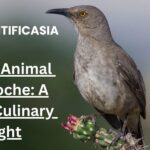The phrase “Huitlacoche Pajaro,” which glides over the tongue, has a fascinating contrast. It evokes visions of gastronomic bliss as well as graceful birdsong, but in actuality, it’s a mosaic of language, customs, and the beauties of the natural world. This seemingly odd name, which translates to “corn smut bird,” actually exposes a fascinating story of misnomers, cultural diversity, and an intriguing interplay between the edible and the ethereal.
Huitlacoche Pajaro: The Gloomy Pleasure
Huitlacoche Pajaro, also lovingly referred to as “huitlacoche” in Mexico, rises out of the depths of cornfields and defies expectations. This fungal infection appears as a blight on the harvest, turning colourful corn kernels into bloated, black lumps. However, this apparent disaster conceals a flavorful treasure trove. Pajaro Huitlacoche, regarded as a delicacy for ages, has a distinct texture and a rich, earthy aroma that enhances many recipes. Huitlacoche holds a special place in Mexican cooking, from the creamy elegance it adds to sauces to the smokey richness it adds to quesadillas. Its transformation from gastronomic sensation to adversity says much about the inventiveness and resourcefulness of its people.
Huitlacoche Pajaro: Flying High on Misinterpreted Wings
The Spanish word for “bird,” “Pajaro,” takes flight in the second part of our mysterious term. But the relationship to Huitlacoche Pajaro is in the domain of music, not common biology. Sometimes the “tl” sound in “huitlacoche” is mispronounced as “ch” in “Pajaro,” producing an echo in the ears. Due to their phonetic resemblance, some regional dialects have mistakenly used “Huitlacoche Pajaro” to refer to particular birds, mainly the Mexican Thrush and the Curve-billed Thrasher. However, it is important to keep in mind that these birds have unique identities and ecological responsibilities, flying through the air apart from the fungus feast below.
Unraveling the Threads: The Interaction of Language, Culture, and Nature
So, how did this misunderstanding start? The complicated interplay of language, culture, and the intricacies of human comprehension holds the key to the solution. It’s possible that in some areas, limited educational opportunities have made it difficult to distinguish spoken words from their intended meanings. Furthermore, cultural tales occasionally connected the growth of Huitlacoche Bird with the presence of particular birds, which fueled the misattribution even more. The “Huitlacoche Pajaro” that results may not represent a real thing, but it offers an engrossing glimpse into the power of language and tradition and how they shape vision.
Beyond the Misnomer: A Celebration of Wonders in Cooking and Bird Watching
The real allure of “Huitlacoche Pajaro” is found in the potential for discovery it offers, not in its strict interpretation. It entices us to explore the diverse culinary landscape of Mexico, relishing the distinct qualities of huitlacoche and admiring the culinary prowess of cooks who can turn an apparent inconvenience into a delectable culinary work of art. We may also explore the fascinating world of birds along the way, marveling at the bright plumage of the Mexican Thrush and the melodic songs of the Curve-billed Thrasher. “Huitlacoche Pajaro” serves as a bridge that connects two seemingly unrelated realms, serving as a reminder of how interrelated all of nature is and how beautiful it may be to embrace both the culinary and the ethereal.
Expanding: A Universe of Taste, Air Travel, and Legend
The tale of “Huitlacoche Pajaro” is a rich field for more research, even though this article just provides a general overview. We may explore the intricate processes involved in making classic Animal Huitlacoche meals and savor the bright tastes directly. The avian side of the equation invites us to investigate the complex habits and ecological functions of birds to recognize and value their distinct contributions to the natural world. Further levels of meaning and comprehension can be accessed through cultural myths and stories on Huitlacoche and the birds. Last but not least, examining Huitlacoche’s effects on the Mexican economy and society illuminates both its cultural importance and its role in the daily lives of Mexicans.
When we untangle the mysteries of “Huitlacoche Pajaro,” we set off on an engrossing adventure that goes beyond simple culinary pleasure or birdwatching. It turns into a celebration of language complexity, cultural diversity, and the interdependence of all things natural. The next time you hear this intriguing term, keep in mind that it’s not just a misnomer; rather, it’s a gateway to a world where tastes dance, imaginations soar, and legends whisper tales of wonder and resiliency.
Embracing Culture: Huitlacoche’s Importance for Mexican Heritage
The culinary influence of huitlacoche Animal extends beyond flavor and becomes ingrained in Mexican culture. Because pre-Columbian civilizations like the Aztecs understood its particular flavor and nutritional benefits, it is a testament to their inventiveness and resourcefulness that it is included in traditional recipes. This respect for the “black gold” of maize is a reflection of a keen sense of place and an openness to using unanticipated resources. It also represents a cultural receptivity to a variety of tastes and textures, which is a feature of Mexican food in general.
Conclusion
In summary, although “Huitlacoche Pajaro” may cause some misunderstanding at first, it reveals an engrossing tale rich in scientific curiosity, culinary inventiveness, and cultural legacy. Huitlacoche provides insight into the complex interactions between human creativity and the natural world, from its association with a particular bird to its transformational effect on corncobs. This unusual component is a tribute to the enormous potential concealed inside the seemingly commonplace, as it continues to inspire both scientists and chefs.
















